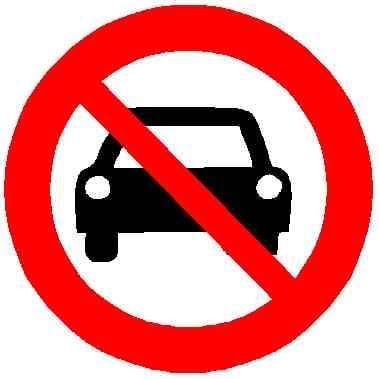Some say that cars represent freedom and the ability to go where you want when you want.
But tech oligarchs want to destroy that, too. Basically by having their cars require a connection and monitor your ever movement within the car and where you are going and when. They also are obsessed with self-driving cars because they then would have more control over your movements.
In short there will BE no plus side to having a car in the very near future. They are enshittifying everything.
a 175m wide road would be well over 35 lanes of car traffic, closer to 58. Not 7.
Just as a 9 meter wide space for metros would be just for metros.
id wager that in toronto, you could build all the subways and LRT and trains, and the road traffic would stay the same. people don’t look at cars just for convince, its a cultural thing in north America, that your life is sorted out, like having a house, a good job, savings/retirement fund. people look and treat you weird if you don’t have a car or can’t drive (ask me how i know that)
People ARE assholes like that, but they will take nice public transit if it’s convenient. Especially if you want to have a drink or two going out or to a friend’s house.
Sometimes if it’s really convenient people take it instead of driving in rush hour which helps everyone!
you would be surprised how many people drink and drive. im telling you, unless there’s a dramatic shift in culture around transportation, or the next generation realizes that cars aren’t a great thing to be using, if someone can get a car and a license, they will do so as soon as possible, its so engrained even some jobs require you to have a license. People will use that lame duck as a excuse to get one.
That’s why road diets and reducing road capacity is also important. Like Amsterdam, Copenhagen, Madrid or Vienna, the space dedicated to cars also have to be reduced in order to incite people to use something else than a car.
they tried doing that in a stretch of toronto and it was removed as soon as it was put up, the drivers just have that much leeway here
Helsinki just had 0 traffic deaths this past year because they focused all their funding on improving public transportation and bike lanes, disincentivizing car use, and punishing motorists who use their phone or speed by setting up cameras.
I sure wish somebody would look at that incredible success story and try to emulate it here. Unfortunately, public transit seems to be getting less reliable over time instead, which just encourages more car use.
Where’s “here”?
USA.
America?
Infographic not to scale (for some reason)
That pisses me of too. Especially since cars are even worse than the infographic makes it look like.
One should include bikes and also costs per person per journey. Will probably need logarithmic scale.
My limited experience with public transit in Texas is that it costs way more for me because I still have to drive 25 miles to the train station, pay 10 bucks to park, pay another 10 for the train that only comes like 5 times a day, walk the last mile in 110 degree heat, and come back earlier than I’d like to catch that final train trip and then pay for a new window for my car because someone broke into it.
Seriously - we suck at transit here.
That’s a wide track…
I’m curious about the numbers for tram.
Somewhere between buses and trains.
Not sure about English terminology but I thought tram and metro are the same and it’s small trains that go on the street or maybe have a separate lane?
Tram (also known as streetcar or trolley) usually goes on rails in a street that is shared with cars. A metro (also known as subway or underground) usually has it’s own separated tracks that are often underground or elevated.
While ‘trolleybuses’ are electric buses which get power by wire. They have the advantage that they are far cheaper to set up than trams, while providing less capacity.
Metros are also called subways or undergrounds.
There are some cities where trams function like metros (have dedicated tunnels for part of the route), but usually the two are separate systems, with different types of rolling stock.
Metros usually go faster than trams, because they don’t interact with other traffic, and have less frequent stops.
TIL thanks! We have the same difference in German. I just matched metro to the wrong one.
interesting. i think in our city, trams and metro are not clearly separated. parts of the trams’ tracks run on their own lane, while other parts mix with the other traffic.
A 175m road scaled in reference to the 35m wide lane:

i mean yeah but how much of that energy can you get out of that uranium, and at what speed?
Thank you for this, the picture was really bothering me.
Quality contribution. I completely overlooked the relative sizes.
I completely overlooked the relative sizes.
Your mum’s fat. And so is your nana.
relatives 🥁
Yeah i was thinking that too, no way 175m is that narrow.
Thank you! That really bothered me but I was also too busy (read: lazy) to illustrate it myself.
Metros are good for extremely heavy lines and lrt/tram/whatever other similar form of transit is good for convenience and accessibility(that even well built cities often ignore…) but the king is still bikes in my opinion. I live in a city of 150k so its quite a bit smaller than most places where youd have more mass oriented transit but its still interesting to see that the fastest path to city center is with bike. Not bus, not train(except if you live right next to it) and not car.
I was gonna say people need to sacrifice for the greater common good but then I realized what community this was and knew people were on my same wavelength.
Now do it with lifted pickup trucks assuming 1.25 seating capacity use
Okay, but if you look carefully at the top of the inverted pyramid, you’ll notice that there are no homeless people allowed to participate.
Also, the bottom has no less than six trees which is Woke.
The whole thing stinks of socialism.
Like we should, idk, pool our resources to “improve” our lives or something…
Nah, I’d rather burn prehistoric forests in my trukk because I’m so free.
America, fuck yeah
“Now I’m gonna go roll coal just to own the libz”
I guess for bicycles, you’d get that down to about 7 meters. Estimated from heavily used bike lanes in Copenhagen where at rush hour two bikes per second pass (7200 persons per hour). Edit: Here is a video of bike rush hour in Amsterdam - try to count the number of persons passing per second.
Fun fact: The distance at which bikes with good paths are faster than metros / rapid transit / commuter rail, or light rail is surprisingly large. I commute to the center of Munich, 14 kilometers one way. It is about 50 minutes on the bike and 60-75 by light rail. And I go at leisurly speed. Plus the bike is much more reliable (outside of icy winter weather, where bike paths are not cleared).
Edit: I’d like to add that for bikes, you don’t need necessarily need a single 7 meter wide connection. Four connections, each 2 meters wide, will do fine, too!
Thanks for that. I wonder if anyone has developed a rough algorithm for it? I’m sure it depends on the infrastructure. My city is maybe 25% designed for bicycles (optimistically) so I imagine it would score lower than a lot of modernized European metro areas. And that makes me sad.
The season just ended, but every Monday I go cycling though a different urban neighborhood with ~600 other people so hopefully we can make an impression and improve things.
I have seen web sites which show the estimated average travel time from one place in a color-coded map.
Practically spoken, you can compare the estimated travel time from public transit apps or google maps with rough route planning in openstreetmap.org.
Concretely, I use the https://brouter.de/brouter-web app at my PC to plan commute routes, and set my own average speed (which is about 15 km/h - younger people with a bit of training might reach 20 km/h). (One could also use the OSMand app on the smart phone (or one of its open source forks), which underneath uses openstreetmap and brouter as well. But I find the phone display just too small to do that comfortably).
The trick for going fast, safe and relaxed along longer distances is to select routes with few intersections and traffic lights. In my case, around 35% of the daily commute is a cyclepath at the side of a motorway, 20% is along Munich’s river Isar, much of the rest are so-called bike roads with reduced speed for cars which attract a lot of bike traffic in the city.
Oh, and if you ever need to commute longer distances outside cities, consider a velomobile (for smooth concrete roads) or a recumbent bike (for dirt roads). They are great for that and you get more speed for your energy.
the problem with bicycles is they are not weather proof. if it’s cold or hot or stormy or hails, bicycles suck. then on top you’re excluding people who are not physically fit enough to use a bicycle for more than 5 minutes. and that includes people with disabilities of all kind.
so you still need public transport options anyway. on days with bad weather, you can expect that at least 90% of people are gonna prefer public transport, so you have to size your buses and trams large enough to carry the full population anyways.
so now you already have full public transport. at this point, why bother with bicycles, apart from the fun and physical exercise people get?
that’s why i conclude that bicycles are only for recreation/sports, not actually for mass transport.
the problem with bicycles is they are not weather proof. if it’s cold or hot or stormy or hails, bicycles suck.
You can certainly use bicycles in many kinds of weather. Because this is a world-wide forum, we need to be a bit more specific about the weather conditions:
-
You can ride bikes when it is raining, even heavily so. (Here in Germany, this happens less frequently than 20 years ago). Good rain clothes help with that.
-
You can also ride a bike during stormy weather, though one needs to be a bit more careful. Said that, I have lived in Scotland and Northern Germany (which often has stormy weather in winter), and have been blown off my bike only a single time in, wait, over 40 years. And no, I am using bikes all the time - I never had a car.
-
You can also ride bikes in quite cold weather - they are popular in Finland even in deep winter. What you do need to do then is to protect your extremities, especially hand and feet and also the face, against the cold. I use bar mittens (like these) for long rides in temperatures below - 10° C, and I find them super comfortable. If the road is a bit icy, studded tyres are great! In Germany, not much people use bikes in icy weather but this is mostly due to bike paths not cleaned from ice by the municipal road service, snow is melting and freezing again for days so that they can not be used in a safe way. In Finland, things are different, and bikes are used even in deep winter, as a preferred mode of transport.
-
The limit is probably for extremely hot and humid temperatures, like are frequent in India, East-Asia, and some parts of Brazil. Here in Southern Germany, we rarely have above 33°C and perhaps 60% humidity, and being on the bike is still more comfortable than using a bus with poor ventilation, and much more comfortable than using a car without AC. Actually, I have now read several times of incidents in summer where AC was broken in very full trains, but never of any health damage a person took because of commuting by bike in hot weather. That’s because the movement provides ventilation by the headwind, and ventilation cools (at that European level of humidity). (One more funny thing is that in Germany, AC in cars became only popular in the last 15 years or so. Now, some people are saying that on a bike, you “get too sweaty” for working in an office in Summer. That’s funny, because entering a car without AC on a warm day was always like entering an oven, but nobody ever suggested to use the bike instead because it was less hot. All in all, that is just one of the many ways how people use made-up arguments to rationalize decisions that maximize their comfort, but are bad for their health).
then on top you’re excluding people who are not physically fit enough to use a bicycle for more than 5 minutes. and that includes people with disabilities of all kind.
I think you are making a mistake here, and this seems to affect the central point of your argumentation: You are assuming that somebody is demanding that a whole city uses either bikes or public transport, in an exclusive way. In reality, bikes and public transport are superb complements. Reasons for that include speed, economical factors, travel time, last-mile connections, urban life and more. Last not least because public transport in metros is two orders of magnitude more expensive than bikes, and therefore always limited in capacity. You can see this is way: Each time you are using a crowded metro, bus or street car, when you could as well go by bike, you are taking away a place from an perhaps elderly or ill person which really needs it.
In contrary, cars are not helpful for disabled and elderly people: Not only they can often not drive them, but they take away walking space and make their transport less safe.
so you still need public transport options anyway.
Of course, nobody was saying that one should exclusively use bikes! This is a strawman argument.
on days with bad weather, you can expect that at least 90% of people are gonna prefer public transport, so you have to size your buses and trams large enough to carry the full population anyways.
That depends a lot on culture and also on whether you have safe bike paths. Generally, normally rain, warm or cold weather does not impede cycling. What is making the difference is safe infrastructure and ways. One can see that clearly from the enormous rise of popularity of using bikes in Paris, once the necessary safe infrastructure was there.
so now you already have full public transport. at this point, why bother with bicycles, apart from the fun and physical exercise people get?
Again, bike and public transport are great complements - public transport will always be needed for elderly / disabled / ill people, and commuting or travelling large distances, and bikes are more economical, faster, and more convenient for shorter distances.
that’s why i conclude that bicycles are only for recreation/sports, not actually for mass transport.
Looks like you never have lived in a city or culture where the bike is a normal mode of transport. I guess you are American?
(And yes, I am aware that a community like this one which discusses alternatives to fossil-free transportation, might be frequented by poorly-informed people and also be targeted by astroturfing and 10-cent armies directed by the fossil fuel industry… one sees this in every discussion on climate protection.)
(And yes, I am aware that a community like this one which discusses alternatives to fossil-free transportation, might be frequented by poorly-informed people and also be targeted by astroturfing and 10-cent armies directed by the fossil fuel industry… one sees this in every discussion on climate protection.)
downvote for insinuating that i’m a paid bot of the fossil fuels industry for disagreeing with you.
-
Or just work remotely from home.
Yeah I had a commute through Boston US and the subway took 40-45 mins including 5 mins walk each end and the bike took 30-33 mins door to door. Subway was 50-70 for a while there when overdue critical repair work was ongoing. The subway route was straighter too.
Very much not proportional this representation.
Can the roughly 1000 people per minute board the metro in a minute?
Or rather, since there are 2 metros in 9m, and traffic in all directions, can 500 people board a metro in a minute if another 500 people have to unboard first, or just 100 if not everybody uses the same stop?
Yes, these kinds of transfer numbers are easily possible (even though other posters have said you don’t actually have 1,000 getting on or off at one stop). As an example, consider the subway of Toronto, Canada on its busiest line, Line 1. A subway train is 138m (450 ft) long with 6 cars (though there is no internal barrier between cars) and a capacity of about 1,500 people. Each car has 4 door sets per side, and these door sets are about 1.5m (5 ft) wide. People can easily fit through them in pairs, so moving 4 or more people per door set when in a rush is very doable. With 24 door sets (only one side opens at a station), that’s 96 people entering or exiting per second, so 10 or 11 seconds for 1,000 people. If you think 4 per second per door is too optimistic, then it’s 1,000 people in 20 seconds.
Have you ridden trains? Like, commuter trains? the NYC subway handles millions of riders per day. The trains have many doors.
Not a problem. Stations where a lot of people board and unboard at the same time have sometimes platform where one side is for boarding, and the other for unboarding. Plus, trains can have more doors per car.
As you said, not every one of the 1000 board/unboard on the same stop. So, let’s analyze your 100 per stop figure: The modern (subway) trains that I use daily can carry 1000 people, are roughly 120m long, and have 18 double doors per side. That’s like 6 people per door, totally doable.
Usually these systems rely on people getting on/off at different stops, rather than one stop seeing full volume. If it’s one stop, chances are it’ll look like a terminus station and you’ll need several platforms and possibly dual-side boarding to each train. It’ll be quite a bit wider than tracks with no station, or a minimalist station.
This is pretty common at major sports arenas.
The same of course applies to other transit options: high-capacity bus stops take up space, and motorway interchanges and especially carparks also take up a lot of space.
Usually these systems rely on people getting on/off at different stops, rather than one stop seeing full volume. If it’s one stop, chances are it’ll look like a terminus station and you’ll need several platforms and possibly dual-side boarding to each train. It’ll be quite a bit wider than tracks with no station, or a minimalist station.
yeah, on the tram line i typically take, we have like 1 stop where lots of people get on/off, like 30 people per door, and it always takes 1-2 minutes to unload all the people/new people to enter. i think it’s just outright planned-into into the route’s timing plan.
If you want to account for boarding platforms in the metro example, you also have to account for the parking in the car example to make a reasonably fair comparison.










